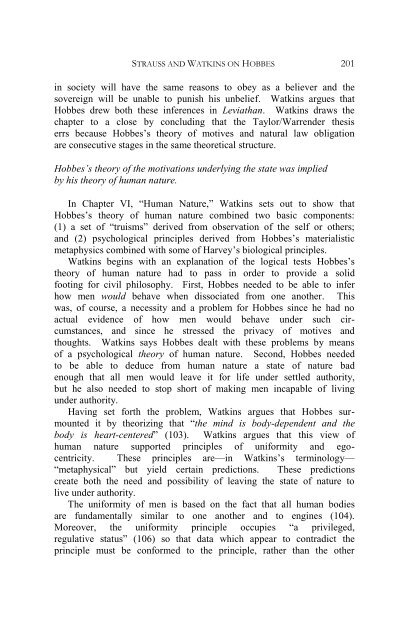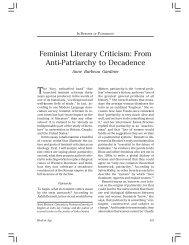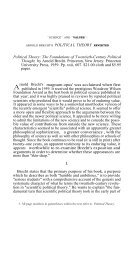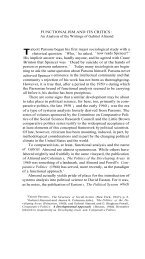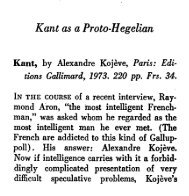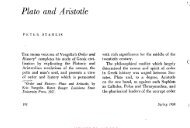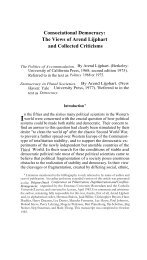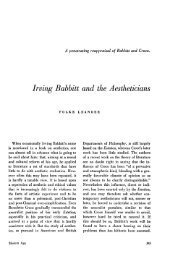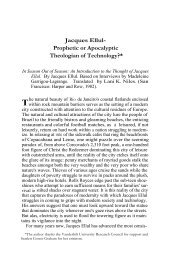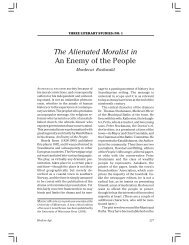Strauss and Watkins on Hobbes' Political Philosophy: A Review
Strauss and Watkins on Hobbes' Political Philosophy: A Review
Strauss and Watkins on Hobbes' Political Philosophy: A Review
Create successful ePaper yourself
Turn your PDF publications into a flip-book with our unique Google optimized e-Paper software.
STRAUSS AND WATKINS ON HOBBES 201<br />
in society will have the same reas<strong>on</strong>s to obey as a believer <str<strong>on</strong>g>and</str<strong>on</strong>g> the<br />
sovereign will be unable to punish his unbelief. <str<strong>on</strong>g>Watkins</str<strong>on</strong>g> argues that<br />
Hobbes drew both these inferences in Leviathan. <str<strong>on</strong>g>Watkins</str<strong>on</strong>g> draws the<br />
chapter to a close by c<strong>on</strong>cluding that the Taylor/Warrender thesis<br />
errs because Hobbes’s theory of motives <str<strong>on</strong>g>and</str<strong>on</strong>g> natural law obligati<strong>on</strong><br />
are c<strong>on</strong>secutive stages in the same theoretical structure.<br />
Hobbes’s theory of the motivati<strong>on</strong>s underlying the state was implied<br />
by his theory of human nature.<br />
In Chapter VI, “Human Nature,” <str<strong>on</strong>g>Watkins</str<strong>on</strong>g> sets out to show that<br />
Hobbes’s theory of human nature combined two basic comp<strong>on</strong>ents:<br />
(1) a set of “truisms” derived from observati<strong>on</strong> of the self or others;<br />
<str<strong>on</strong>g>and</str<strong>on</strong>g> (2) psychological principles derived from Hobbes’s materialistic<br />
metaphysics combined with some of Harvey’s biological principles.<br />
<str<strong>on</strong>g>Watkins</str<strong>on</strong>g> begins with an explanati<strong>on</strong> of the logical tests Hobbes’s<br />
theory of human nature had to pass in order to provide a solid<br />
footing for civil philosophy. First, Hobbes needed to be able to infer<br />
how men would behave when dissociated from <strong>on</strong>e another. This<br />
was, of course, a necessity <str<strong>on</strong>g>and</str<strong>on</strong>g> a problem for Hobbes since he had no<br />
actual evidence of how men would behave under such cir-<br />
cumstances, <str<strong>on</strong>g>and</str<strong>on</strong>g> since he stressed the privacy of motives <str<strong>on</strong>g>and</str<strong>on</strong>g><br />
thoughts. <str<strong>on</strong>g>Watkins</str<strong>on</strong>g> says Hobbes dealt with these problems by means<br />
of a psychological theory of human nature. Sec<strong>on</strong>d, Hobbes needed<br />
to be able to deduce from human nature a state of nature bad<br />
enough that all men would leave it for life under settled authority,<br />
but he also needed to stop short of making men incapable of living<br />
under authority.<br />
Having set forth the problem, <str<strong>on</strong>g>Watkins</str<strong>on</strong>g> argues that Hobbes sur-<br />
mounted it by theorizing that “the mind is body-dependent <str<strong>on</strong>g>and</str<strong>on</strong>g> the<br />
body is heart-centered” (103). <str<strong>on</strong>g>Watkins</str<strong>on</strong>g> argues that this view of<br />
human nature supported principles of uniformity <str<strong>on</strong>g>and</str<strong>on</strong>g> ego-<br />
centricity. These principles are—in <str<strong>on</strong>g>Watkins</str<strong>on</strong>g>’s terminology—<br />
“metaphysical” but yield certain predicti<strong>on</strong>s. These predicti<strong>on</strong>s<br />
create both the need <str<strong>on</strong>g>and</str<strong>on</strong>g> possibility of leaving the state of nature to<br />
live under authority.<br />
The uniformity of men is based <strong>on</strong> the fact that all human bodies<br />
are fundamentally similar to <strong>on</strong>e another <str<strong>on</strong>g>and</str<strong>on</strong>g> to engines (104).<br />
Moreover, the uniformity principle occupies “a privileged,<br />
regulative status” (106) so that data which appear to c<strong>on</strong>tradict the<br />
principle must be c<strong>on</strong>formed to the principle, rather than the other


